The Sprint HTC EVO 4G Review
by Anand Lal Shimpi on June 28, 2010 6:04 PM ESTIt’s really not that big. It seems like it would be based on the specs and photos, but in reality the Sprint EVO 4G by HTC just isn’t that big. And it’s not levied as an insult, I just mean to say that the EVO is manageable in size.
The screen has the same 800 x 480 resolution of the Nexus One and HTC Incredible, but the pixels are spread out over a much larger 4.3” screen. The display setup to be overly red just like the other Android screens we've seen thus far, but it looks great.

The size of the screen is really what sets the EVO 4G apart from the competition, and honestly I couldn’t think of a better phone for browsing the web. Loading full websites is a pleasure and the screen is large enough where you can actually read a lot of content. It's not a tablet replacement, but it is easier to work with than a 3.5 - 3.7" screen.
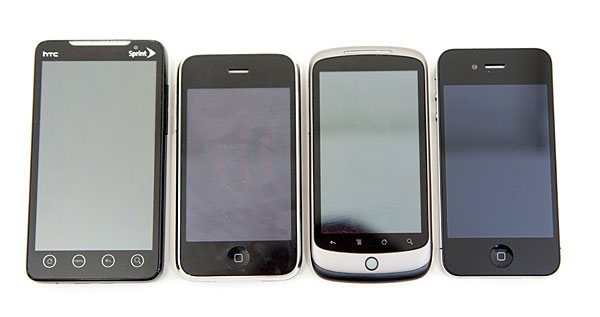
From left to right: HTC EVO 4G, iPhone 3GS, Nexus One, iPhone 4
I’ve heard it referred to as a mini tablet and honestly I don’t believe that’s the case. The 4.3” screen is big but I’m telling you, it’s not that big in practice. It just ends up feeling like a phone with a good sized screen. Move into the 5” and beyond territory and then you start triggering me calling things tablets.
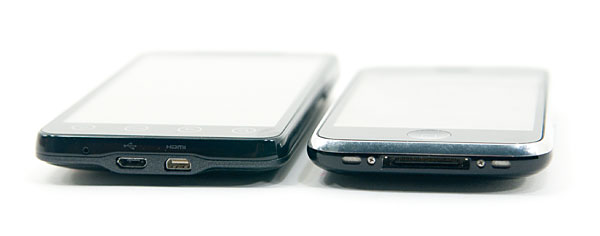
HTC EVO 4G (left) vs. iPhone 3GS (right)
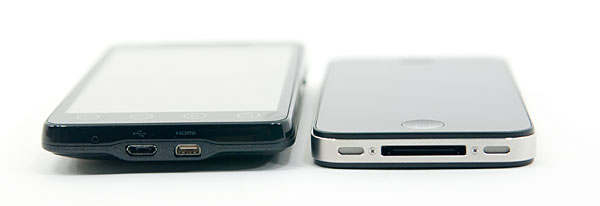
HTC EVO 4G (left) vs. iPhone 4 (right)
The phone measures 4.8” x 2.6” x 0.5” and it’s the largest smartphone I’ve ever held. That being said, it is absolutely pocketable as long as you’re not wearing skinny jeans. Even then it is thin enough that you could slip it into your back pocket.
| Physical Comparison | |||||||
| HTC EVO 4G (Qualcomm Snapdragon QSD8650) | HTC Droid Incredible (Qualcomm Snapdragon QSD8650) | Apple iPhone 4 | Google Nexus One (Qualcomm Snapdragon QSD8250) | ||||
| Height | 121.9 mm (4.8") | 117.5 mm (4.63") | 115.2 mm (4.5") | 119 mm (4.7") | |||
| Width | 66.0 mm (2.6") | 58.5 mm (2.30") | 58.6 mm (2.31") | 59.8 mm (2.35") | |||
| Depth | 12.7 mm (0.5") | 11.9 mm (0.47") | 9.3 mm ( 0.37") | 11.5 mm (0.45") | |||
| Weight | 170 g (6.0 oz) | 130 g (4.6 oz) | 137 g (4.8 oz) | 130 g (4.6 oz) | |||
| CPU | Qualcomm Scorpion @ 1GHz | Qualcomm Scorpion @ 1GHz | Apple A4 @ ~800MHz | Qualcomm Scorpion @ 1GHz | |||
| GPU | Adreno 200 | Adreno 200 | PowerVR SGX 535 | Adreno 200 | |||
| RAM | 512MB LPDDR1 | 512MB LPDDR1 | 512MB LPDDR1 (?) | 512MB LPDDR1 | |||
| NAND | 8GB micro SD | 8GB micro SD | 16GB or 32GB integrated | micro SD | |||
| Camera | 8MP with dual LED Flash + Front Facing Camera | 8MP with LED Flash | 5MP with LED Flash + Front Facing Camera | 5MP with LED Flash | |||
| Screen | 4.3" 480 x 800 | 3.7" 480 x 800 AMOLED | 3.5" 640 x 960 LED backlit LCD | 3.7" 480 x 800 AMOLED | |||
| Battery | Removable 5.5Whr | Removable 4.81 Whr | Integrated 5.254 Whr | Removable 5.18 Whr | |||
HTC ditched the silly scroll ball of the Nexus One and the optical sensor of the Incredible and just left the EVO 4G with a row of touch sensitive buttons along the base of the screen. Home, Menu, Back and Search are all you get.
If you need a navigational aid the screen is big enough where HTC was able to include directional arrows on the on-screen keyboard. They are awkward to use at first because you’re not used to them, but afterwards they just make sense. I hardly used the scroll ball/optical trackball of the other Android phones so HTC’s decision to reclaim that real estate makes total sense to me. The screen is used for scrolling, if you need fine tuned movement just rely on the virtual arrow keys. Fine by me.
The touch screen supports haptics, which can be fully disabled. When enabled certain button presses will cause the EVO’s motor to vibrate a bit to confirm the touch. It’s a concession for those who still want some tactile feedback.
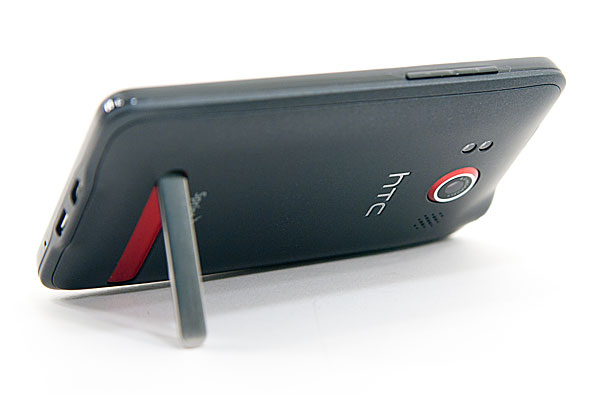
The EVO 4G is the first Android phone I’ve used with something interesting on its back: a kickstand. The metal stand lets you prop a horizontally oriented EVO on your desk at around a 45 degree angle. It’s great for watching videos, using as a clock or an alternative to a costly dock.
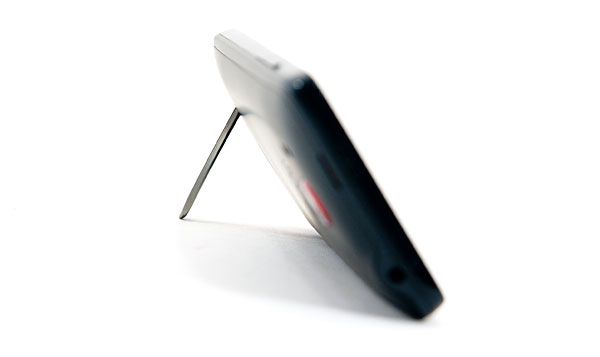
The stand is actually a nice touch, unfortunately the Android UI doesn’t rotate to landscape mode so it’s only useful within apps that support rotation.
Also on the back is the 8MP camera lens (there’s a 1.3MP camera on the front), two LED lights used as a flash and a speaker for the speakerphone. Along the bottom is a standard USB micro B connector and a micro HDMI (D-connector) video out. The HDMI out can only be used to output movies, it won’t mirror your display.

As its name bluntly states, the EVO 4G works on Sprint’s 4G WiMAX network. Sprint’s 4G service is currently only available in 43 cities spread over 15 states, if you find yourself in one of those states then the EVO has more than its large screen to tempt you.
The phone currently sells subsidized for $199 from Sprint after a $100 mail in rebate. Service starts at $69.99 for 450 minutes and unlimited messaging/data and goes all the way up to $134.99 per month including tethering.
| Cost of Ownership Comparison | |||||
| AT&T iPhone 4 | Sprint EVO 4G | Verizon HTC Droid Incredible | |||
| Cost of Device | $199 w/ 2 year contract | $199 w/ 2 year contract after $100 MIR | $199 w/ 2 year contract | ||
| Plan with 900 Minutes, Unlimited SMS/Data | $104.99/mo, unlimited SMS, 2GB data | $99.99/mo, unlimited SMS, unlimited data, 4G | $109.98/mo, unlimited SMS, unlimited data | ||
| Tethering | + $20/mo | + $29.99/mo | + $25/mo* | ||
| Total Monthly + Tethering | $124.99/mo | $129.98/mo | $134.98/mo | ||
| Total Cost of Ownership over 2 Years | $2718.76 | $2598.76 after $100 MIR | $2838.52 | ||
| Total Cost of Ownership over 2 Years w/ Tethering | $3198.76 | $3318.52 after $100 MIR | $3438.52 | ||
Without the mobile hotspot service, the EVO 4G is the most affordable smartphone out of the three majors over the course of two years. AT&T actually offers a better deal with tethering but you need to keep an eye on your usage; go over 2GB per month and you'll incur additional charges, which isn't tough to do if you tether a lot.










97 Comments
View All Comments
DaveGirard - Monday, June 28, 2010 - link
you're missing the iPhone 4 in the battery life and there is only one phone in the H.264 page.And I think you need to set your white point properly for the iPhone 4 pics. Saying that's the best picture you can produce is not accurate.
Anand Lal Shimpi - Monday, June 28, 2010 - link
The iPhone 4 review is next, and the white balance was actually a problem for the iPhone 4 - regardless of where I tapped to sample the white balance pretty much came out that way.More on this tomorrow...
Take care,
Anand
SandmanWN - Monday, June 28, 2010 - link
"The size of the screen is really what sets the EVO 4G apart from the competition, and honestly I couldn’t think of a better phone for browsing the web. Loading full websites is a pleasure and the screen is large enough where you can actually read a lot of content, even while zoomed in. I’d be willing to go as far as to say that it is almost too small for the ideal web browsing experience."This whole paragraph is confusing and contradicting. You say you couldn't think of a better phone for web browsing. Then say you you can read a lot even while zoomed in, which I think you meant to say out there. Then you contradict the first sentence and say it is almost too small for web browsing.
I think that paragraph needs a mulligan.
Anand Lal Shimpi - Monday, June 28, 2010 - link
I've cleared it up a bit :)tipoo - Monday, June 28, 2010 - link
It would be great if you could include Evo 4G benchies in the iPhone 4 review.rf40928 - Friday, July 2, 2010 - link
Yeah, I guess u saw the Evo benchmarks.I have an Evo and Im considering a Iphone 4 ( my cousin got one )..
I posted above the following: ... funny how the Iphone 4 review that Anand did proves Iphone 4 on a "slower" 3g network is consistantly faster then the Evo on a 4G network when it comes to the web .. I guess 4G's Peak performance is theoretically better.. but are Sprints 4G average 4g Speed numbers better then ATT's avg 3g speeds?? ..it would seem not.."
yibrushn - Monday, June 28, 2010 - link
Sorry just gotta make 2 corrections. The front camera is 1.3 mp and the screen is TFT not AMOLED.Anand Lal Shimpi - Monday, June 28, 2010 - link
Fixed and fixed :)Hmm that was actually a bit confusing, Sprint lists it as an OLED screen and it is very similar to the OLEDs we've used in terms of color calibration but all the data I can find points to a TFT display.
DigitalFreak - Monday, June 28, 2010 - link
I thought the screen thing might have been a typo, until I saw there was an entire paragraph describing the "AMOLED" screen. :-/Anand Lal Shimpi - Monday, June 28, 2010 - link
That was absolutely my bad. HTC appears to have calibrated the screen to mimic the other OLEDs, it's overly red. Combine that with the OLED listing here http://shopamerica.htc.com/cell-phones/productdeta... and it resulted in my mistake. I was wondering why viewing angle was so bad for OLED, I should've been more careful in my research there instead of just making an assumption. I will be more careful in the future.Thanks again for catching the error early on.
Take care,
Anand